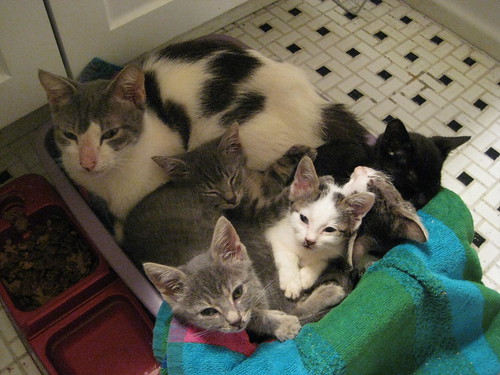As of last week, we have a new batch of foster kittens. We foster from Liberty Humane Society, and keep the kittens until they’re big enough to be fixed and adopted out (2 lbs).
Anyone who follows me on Twitter/Facebook knows that our fostered kittens tend to have a stream of health problems. A few people have commented on our “bad luck” and I thought I’d take the time to explain that fostering feral kittens is unlike raising kittens born to a housecat.
Like most animals born in litters, kittens don’t have the best mortality rate to begin with. The feral kittens are at a distinct disadvantage over the average housecat. For starters, the mother hasn’t been vaccinated against a whole host of diseases. Kittens get antibodies from the mother’s milk, so from day 1 feral kittens are already more susceptible to disease. And unlike your house cat who gives birth on your favorite sweater and eats cat food, feral cats give birth in an alley and eat whatever New Jersey rats they can find running around. Many things which are trivial to an adult cat are fatal to a small kitten.
From there the mom and kittens head to the shelter. The good news is the shelter is able to give them healthy food and treat them for parasites such as worms. The bad news is the shelter is a great place to pick up a URI (head cold) and fleas. The staff do their best to keep sick cats away from healthy ones, but anyone who works in an office knows how hard it is to keep a cold from going around.
Getting the cats out of the shelter and into a foster home is good for a number of reasons. First, it gets their fragile kitten immune systems out of the hot zone of germs. Second, it helps keep anything they may be harboring from spreading around the shelter. Third, they get more attention (both in terms of health care and affection) in a home than they would as one of the dozens of cats at the shelter. And perhaps most importantly, fostering reduces the load on the shelter giving them more resources to care for the animals there.
Our current batch is battling the usual URI, which means a room full of sniffles. The cold isn’t a big deal by itself, but when their noses are clogged they can’t smell, and when they can’t smell they can’t eat. I’m armed with a humidifier, pedialyte, saline nose drops, and subcutaneous fluids to help them fight it off. Subcutaneous fluids are injected under the skin. It sounds scary, but is actually much less of an ordeal than trying to force feed a cat water.
It’s a lot of work, but totally worth it to watch the little bugs chase each other and slide around on our hardwood floors.

from the picture, it looks like you’re fostering the feral mother as well.
how is that going?
kittens on their own, i’ve handled, but with the mother in the picture, i’m curious what the issues are, both interacting with her one on one, and getting access to the kittens with her around.
The biggest issue with the mother was when she got sick and we had to separate them. This pissed her off which she expressed by pooping in the tub.
Other than that, it’s actually easier with her around. It helps that she’s a total cuddle machine, but when the kittens were nursing she took care of them, so we really only had to take care of her.
Now that they’re weaned it’s a different story, I think she’s pawned them off on us permanently.
I’m fostering a 4-5 month old feral kitten for the first time. She’s in a medium sized safe room after being in a large cage for several days at the house of my friend who trapped her. She comes out from under the bed and will play with several toys I’ve placed in the room while I sit in a chair but the slightest move on my part sends her back under the bed. She will play under the bed if I lay on the floor but will not come back out. My other cat (BJ) sits outside of the safe room meowing which the kitten doesn’t pay much attention to. She doesn’t like to be held but if I can “bundle” her in a towel, should I let BJ into the room?
I seem to take one step forward and two steps back – I know it takes patience but it’s also very frustrating. Could use some advice.
If you haven’t yet had your foster checked out by a vet and vaccinated, I wouldn’t let them hang out together just yet. You wouldn’t want your cat to get sick from something the foster is carrying.
I honestly don’t know much about cat socialization, since we generally take in litters and don’t have a permanent cat. However, I don’t think either cat would be into the idea of being wrapped up in a towel, so it seems like a stressful way to introduce them. Maybe check out some of the online resources for how to do it?
I am not good at this either, but have heard about distributing items carrying the scent of either cat to the other one. This way, they are supposed to get used to the smell. Its also about conditioning, so you would have to connect some pleasant activity, food or special human attention to that.